The Enduring 1903 Barber Dime
Posted on — Leave a commentIn 1891, Congress authorized U.S. Mint Director Edward Leech to redesign silver coins in the country. Chief engraver Charles Barber began the process by hosting a contest and inviting artists to participate. He requested low relief designs and made clear that the winner would be awarded a cash prize. While open to the public, Leech specifically sought out the ideas and artwork of several specific artists. The value of the prize was $500.
This plan was quickly upended when the invited artists explained that they were not happy with the terms set in the competition.
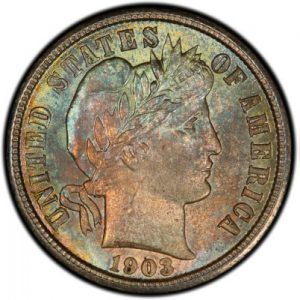 The artists insisted that the judges must consist of a group of peers, rather than government officials. Additionally, they wanted a single artist to design both sides of the coin rather than create a piece that depicts two different styles. Finally, they requested more time for the contest. Leech was unwilling to meet any of these requests. As a result, the artists invited to participate withdrew.
The artists insisted that the judges must consist of a group of peers, rather than government officials. Additionally, they wanted a single artist to design both sides of the coin rather than create a piece that depicts two different styles. Finally, they requested more time for the contest. Leech was unwilling to meet any of these requests. As a result, the artists invited to participate withdrew.
This difficult start to the process only invited more problems. After reviewing the submissions that were received, Leech remarked that they were all “wretched failures.” He continued that “only two of the three hundred suggestions submitted were good enough to receive honorable mention.”
This disappointing outcome left Leech with only one option: he asked Barber to draft the new designs himself. This was a considerable task given that Leech would need a new design not only for the dime, but also for the quarter, and a half dollar. However, even Barber’s work proved unsatisfactory at first and Leech rejected the initial designs. Despite the rejection, Barber continued to work and finally drafted designs that met with Leech’s approval.
Each of the pieces in Barber’s collection show the head of Liberty facing right with a pileus, which is a brimless, felt cap originally worn in ancient Greece. Around this Liberty wears a headband with “Liberty” inscribed on the front.
Despite the beautiful look of the coins the pieces received a tepid response from critics upon their debut. Some of the detractors argued that the coins should show bolder, more original designs that show greater contrast to the previous circulation.
Among the set of coins the 1894-S dime remains a great rarity. In 2005, one sold for $1.3 million. In 2007, another sold for $1.9 million. Much of the appeal comes not only from its rarity but its mystery; no one knows why so few were minted.
Today the 1903 dimes are an excellent way for enthusiasts to start their collection because the pieces were minted in such vast quantities. In fact, the Philadelphia Mint produced 19.5 million dimes which is greater than the minting of the quarter dollar, half dollar, and dollar combined. For this reason many high-quality, affordable pieces are still available today.
Want to read more? Subscribe to the Blanchard Newsletter and get our tales from the vault, our favorite stories from around the world and the latest tangible assets news delivered to your inbox weekly.
Is Fiat Money Under Fire?
Posted on — Leave a commentYou’ve probably heard that U.S. inflation levels remain elevated. In August, the Consumer Price Index climbed 5.3% on a year-over-year basis.
While inflation in 2021 can be blamed on a variety of factors like supply chain bottlenecks and pent-up consumer demand to expansive Federal Reserve monetary policy, new research from Deutsche Bank highlights another simple reason.
The U.S. dollar is a fiat currency – which means it isn’t backed by a commodity like gold.
Throughout history, fiat currencies opened the door to faster inflation and rising debt, Deutsche Bank said.
“With structural government deficits, soaring debt, and money printing now seemingly essential for the global economy and markets to stay afloat over most of the business cycle, policy makers are increasingly putting stress on this monetary framework and shouldn’t take it for granted that fiat money will survive,” Deutsche Bank’s strategists said.
Sound dramatic? The source is reputable indeed. Deutsche Bank is one of the world’s leading financial service providers. Founded in 1870 in Berlin, today Deutsche Bank spans 58 countries and is one of the largest banks in the world by total assets.
Let’s look closer at the trends that are devaluing the U.S. dollar:
- Inflation
- Debt
- Dollar devaluation
Inflation is rising. Not only in 2021 – but as a cumulative factor over decades.
For example, this inflation tool shows you that what cost you $100 in 1986 – costs you $238.45 today. The cumulative impact of inflation over the past 35 years reveals a decline in the purchasing power of the same $100.
Declining value of the U.S. Dollar. Another trend that impacts the value of your money is the actual value of the U.S. Dollar Index. Since January 1986, when the U.S. dollar index stood at 122.15 to 92.55 today (September 2021) – the value of the U.S. dollar index fell by 24%.
It’s a double whammy. Not only does rising inflation, or the higher cost of things you buy erode your purchasing power, but the value of the U.S. dollar itself is falling. That’s a bad combination.
Government debt. Then there is the ever-rising U.S. national debt – which stands at a record-high $28.7 trillion. While the government’s debt may seem far removed from your personal portfolio, if the nation’s debt load grows too large it could impact your daily financial life in a profound way.
The rising national debt creates large risks to not only our economy, but our stock market too. As our government issues more and more bonds to finance our debt, the supply of U.S. Treasury bond increases. It’s simple supply and demand, the more you have of anything, the less value it has.
At some point, foreigners may lose their appetite to continue buying our bonds to fund America’s spending spree, which could force interest rates to soar higher in the future to entice people to buy U.S. bonds. Higher interest rates typically send stock prices lower, sometimes crashing lower. It is a delicate house of cards. Once the house falls down, the shock waves could be strong.
The risks to fiat currencies are clear.
The case for diversification into tangible assets like gold are also clear.
Gold is no one’s liability (no government debt is attached to gold) and it carries no counterparty risk. Gold is accepted in every country around the world as a store of value. Holding gold as part of your portfolio is a proven diversifier, it provides competitive returns compared to other assets and offers downside protection.
Have you considered if you own enough today?
Want to read more? Subscribe to the Blanchard Newsletter and get our tales from the vault, our favorite stories from around the world and the latest tangible assets news delivered to your inbox weekly.
Slowly at First, Then All at Once: Understanding The Threat of a Global Economic Collapse
Posted on — Leave a commentThe Delta variant has taught us – for the second time – just how fast the future can change. What was supposed to be a continued recovery reversed in mere months. Today, the outlook for the globe is dimming. 
Originally the threat presented by COVID was clear: social distancing and illness meant that economic activity fell dramatically. Nearly two years later the picture has changed. The threats are more numerous and more complex.
Consider the food distribution challenges experienced in the UK. Recently, the Food and Drink Federation (FDF) explained that the industry is suffering from a shortage of about half a million workers. One reason: many workers shifted to new jobs in online retail during the pandemic. It is unlikely that any of those who made this switch will go back to their old jobs because their previous work was more demanding and lower paying. Ian Wright, the CEO of the FDF, explained that this “is a structural change that won’t reverse itself.” As a result, UK shoppers are facing a future in which the availability of various foods in restaurants and supermarkets will be unpredictable.
This situation is not a collapse by any means, but it does illustrate the complex and unexpected ways in which COVID is restructuring our lives today and in the future. Other changes, however, are more sobering.
Nomura, a global financial services group spanning 30 countries has created what they call an “early warning model for financial crises.” The system combines five early warning indicators including, private credit-to-GDP ratio, debt service ratio, real property price, real equity price, and real effective exchange rate. These indicators are examined across 40 economies. Since the early 1990s the system, called “Cassandra” in reference to Greek mythology, has correctly warned of two-thirds of the past 53 financial crises that have occurred.
Robert Subbaraman, the Managing Director at Nomura, explains that “a crisis takes a much longer time coming than you think, and then it happens must faster than you would have thought.” Today he believes that the environment of rock-bottom interest rates and increasing asset purchases by central banks have made several countries vulnerable to an economic crisis.
The model tells us that any country with a score over 100 is at an elevated risk.
The US has a Cassandra score of 195.
What makes this score so frightening is the fact that so much of the euphoria in the equity markets seems to ignore the looming threats. Stocks in US indexes have enjoyed a major rally YTD. This suggests that many do not understand what lies ahead or are choosing to ignore it.
This dynamic illustrates why “Cassandra” is the perfect name for the model. The Greek mythological character Cassandra was bestowed the gift of prophecy. This power, however, became a burden when Apollo cursed Cassandra thereby ensuring that nobody would ever believe any of her warnings. For the rest of her life, she was doomed because she knew when danger was around the corner but could do nothing to stop it.
To preserve capital, individual investors need to break the curse and listen to the warnings issued by our modern-day Cassandra. Now is the time to rethink investing strategies and ensure the right portion of assets are held in durable stores of wealth.
Want to read more? Subscribe to the Blanchard Newsletter and get our tales from the vault, our favorite stories from around the world and the latest tangible assets news delivered to your inbox weekly.
This Silver Commemorative Boasts One of the Most Complex Designs You’ve Ever Seen
Posted on — Leave a commentTo celebrate the 200th anniversary of Norfolk, Virginia’s growth from a township first formed in 1682 to a royal borough in 1736 – an exciting commemorative silver half dollar was struck – the 1936 Norfolk Virginia Bicentennial.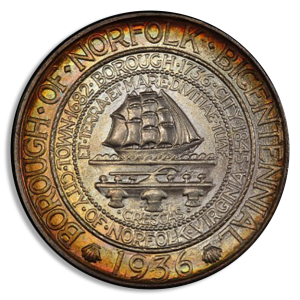
A husband and wife team – William and Marjorie Simpson created the elaborate design for the Norfolk Bicentennial silver half dollar which honors the city’s seaport heritage. It might be one of the most complex designs you’ve ever seen on a coin.
The obverse of this robust coin features a sailing ship placed atop stylized waves and above a plow and three bundles of wheat. A Latin legend is shown above the ship: ET TERRA ET MARE DIVITIAE, which is translated as “Both by Land and by Sea the Riches are.” The coin lists a number of key dates in this cities rich history including the anniversary date of 1936. Lovely scallop shells surround the date on the bottom
The reverse of the Norfolk half dollar reveal a striking Royal Mace and includes the date of the original land grant and the coin’s value HALF DOLLAR, as well as the legends found on many U.S. coins including IN GOD WE TRUST, E PLURBIUS UNION and LIBERTY.
A total of 16,936 Norfolk Bicentennial half dollars were distributed. While this coin is dated 1936, it was actually struck in September of 1937 at the Philadelphia mint.
Coin experts say only 9,000 of these gems survive today at the 65 or higher grade. We have one of these remarkable beauties graded PCGS MS67 CAC.
The 1936 Norfolk Commemorative Half Dollar is an integral part of American coinage. In fact, Norfolks are an essential element of the 50 piece 1892-1954 silver commemorative type set. Numismatists have enthusiastically collected these special commemorative silver pieces since they were first distributed in 1937.
Today Norfolk has grown into a thriving metropolis with a population totaling 238,005 – making it the third largest city in the state of Virginia. The historic financial center is also considered to be the cultural center of the region. Bordered by the Elizabeth River and Chesapeake Bay, the city also has a long history as a strategic military and transportation hub.
Interested in owning this unique rarity? Act now. Rare coins are moving fast in today’s market.
Want to read more? Subscribe to the Blanchard Newsletter and get our tales from the vault, our favorite stories from around the world and the latest tangible assets news delivered to your inbox weekly.
The Case for Gold Diversification Remains Strong
Posted on — Leave a comment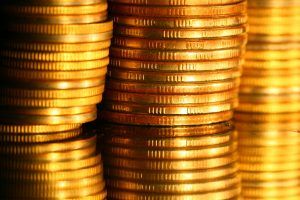 Despite rising inflation, gold has traded in a choppy and corrective manner recently. Some gold investors may be wondering if gold still offers the same level of portfolio protection as it has in recent years.
Despite rising inflation, gold has traded in a choppy and corrective manner recently. Some gold investors may be wondering if gold still offers the same level of portfolio protection as it has in recent years.
While gold is down about 6% year-to-date and silver is down about 10%, that comes on the heels of a 22% gold gain in 2020 and a 44% silver gain last year.
Investors may not realize that gold has delivered long-term average annual returns of 10.8% since the elimination of the gold standard in 1971 – on par with long-term stock market returns. And, when you compare gold performance to commodities over time – gold outperforms.
Consider this data from the August 25 World Gold Council report: Gold: the most effective commodity investment:
“In the Q4 2018 global equity selloff, for example, the S&P 500 fell 15% and commodities fell 9%, yet gold rose 8%. And in the 2020 COVID selloff, the S&P 500 fell 20%, commodities fell 17%, while gold returned 2%. In both recent cases, gold not only protected portfolio assets but also delivered positive returns, while broader commodities behaved more like a risk-on asset.”
Understanding historical performance of assets like gold, bonds, stocks and REITs during previous reflationary periods – can offer insights to investors on what may lie ahead for gold in this cycle. The World Gold Council research reveals that in past reflationary periods, gold historically lagged early in the cycle – just as we are seeing now. But, significantly, gold outperformed over the long run.
The new research confirms that gold allocations of up to 10% in a portfolio delivered better risk-adjusted returns than those with simply broad-based commodity allocations.
If you’ve been wondering about gold’s performance this year, this historical data reveals that what we are seeing is typical. In fact, for long-term investors, the current lower price level of gold allows you to “buy low” and receive more gold in exchange for your dollars.
Here are six key characteristics that the World Gold Council highlighted about gold:
- It has delivered superior absolute and risk-adjusted returns to other commodities over multiple time horizons.
- It is a more effective diversifier than other commodities.
- It outperforms commodities in low inflation periods.
- It has lower volatility.
- It is a proven store of value.
- It is highly liquid.
If you are looking for diversification that counts as a store of value for your wealth, consider increasing your allocation to physical gold. Historical data suggests that gold is on the verge of its next big upswing in price as the economy moves farther into the reflationary phase. If you are under-allocated to gold, don’t miss this opportunity to increase your gold allocation to 10% or even higher depending on your desire for protection.
Gold is a unique asset class that delivers powerful diversification and wealth appreciation opportunities. “Looking at other commodities, some can be considered luxury goods, some have technological applications, and some are basic, everyday products. Some are used to hedge against inflation, some protect against currency devaluation, and all provide a degree of diversification in an investment portfolio. However, only gold performs all these functions,” the World Gold Council said.
Want to explore how you could implement more wealth building assets into your portfolio? Read about our diversification strategy here.
Want to read more? Subscribe to the Blanchard Newsletter and get our tales from the vault, our favorite stories from around the world and the latest tangible assets news delivered to your inbox weekly.
Why Did a CIA Partner Just Buy $50 Million in Gold Bars?
Posted on — 1 CommentPalantir Technologies is a big data analytics company that serves some of the most powerful organizations in the world. One of the three main segments of the company, Palantir Gotham, is a counter-terrorism tool and has a client list including the CIA, NSA, West Point, and Special Operations Command. 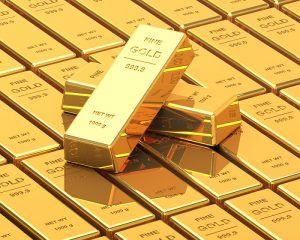 It is no surprise that the company wants to become “the default operating system across the U.S. government.”
It is no surprise that the company wants to become “the default operating system across the U.S. government.”
These relationships put them in an elite class of clandestine organizations with access to information seen by few. This advantage is what makes one of Palantir’s latest moves so interesting.
A single note in the company’s 93-page second quarter earnings report published in mid-August states that they purchased $50.7 million worth of 100-ounce gold bars. For the moment the bars are being held in a third-party location in the northeastern United States.
This move prompts one eager question: why?
The details are scarce but the COO Shyam Sankar explained that the move was part of the company’s aim to shift to more of a worldview. His next comment was more ominous. Sankar added, “You have to be prepared for a future with more black swan events.” His remark seems genuine given that the company has also decided to accept gold as payment from customers.
The market seems in agreement with this view given that gold surpassed a value of $2,000 per ounce for the first time in history as COVID fears mounted in 2020.
The threat of a Black Swan event seems ever-present as the COVID pandemic worsens. Before the term black swan entered the modern lexicon most knew this phenomenon as “tail risk.” A tail risk is the probability of a rare event occurring. The tail is the left and right portion of a normal distribution bell curve.
In a previous Blanchard article we discussed this characteristic of the market and the observation that the world presents risk that often goes unseen until it is too late.
The fact that Palantir made this decisive bet on the future of gold should rally investors to consider their own investments. Is it possible that Palantir is aware of a looming heightened risk? It is impossible to know. It is likely that they have acted on some information that is more than a passing impulse.
Palantir’s software enables businesses to become more efficient and more effective at leveraging what the data they have. This benefit resonates more deeply in a COVID and post-COVID world where gains through traditional business growth are hampered. For this reason more people are likely to take notice of Palantir’s recent investment.
Put simply, when Palantir speaks it is wise to listen. Their additional contracts with the HHS, the Department of Defense, the Justice Department, the Department of Homeland Security, and the SEC are giving Palantir deep roots within the US government infrastructure. Palantir is in the business of seeing just a little bit further down the road, and right now it appears that they see tail risk.
Want to read more? Subscribe to the Blanchard Newsletter and get our tales from the vault, our favorite stories from around the world and the latest tangible assets news delivered to your inbox weekly.
The Panama Pacific Commemorative Coin: The Dawn of a New Age
Posted on — Leave a comment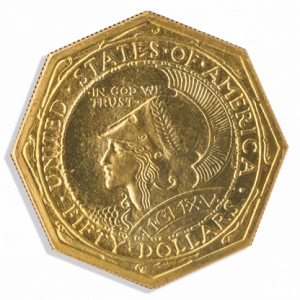 The year 1914 marked the dawn of a new age as the Panama Canal reached completion. Today, the engineering marvel remains a crucial artery of international trade as more than $270 billion worth of cargo passes through the canal every year.
The year 1914 marked the dawn of a new age as the Panama Canal reached completion. Today, the engineering marvel remains a crucial artery of international trade as more than $270 billion worth of cargo passes through the canal every year.
Those behind the project knew the legacy of the canal would be immense. Therefore, they set out to begin planning, and funding the Panama-Pacific International Exposition – a celebration to commemorate the project – years before the canal was complete. These plans were halted when the 1906 San Francisco earthquake destroyed nearly 80% of the city. The death toll surpassed 3,000.
The disaster ultimately changed the underlying meaning of the exposition. While advertised as a celebration of the completion of the canal, the exposition came to symbolize San Francisco’s rise from the devastating events of the earthquake.
Part of the planning included the minting of five Panama-Pacific commemorative coins. The pieces include some of the most original designs created by artists in the US. One coin in particular, the octagonal $50 piece, is the only non-round coin ever minted in the US.
Another one of the five coins is the 1915 gold dollar piece. American sculpture and artist Charles Keck designed the coin. His long and prolific career can be seen across the country. His sculptures are found in places like Oakland City Hall, the Waldorf Astoria Hotel, and the Bronx County Courthouse. His monuments and memorials include, The Lincoln Monument of Wabash in Indiana, and even a George Washington Monument in Buenos Aires, Argentina.
Keck focused his design on those who worked tirelessly to build the canal. The obverse shows the capped head of a construction worker. The reverse shows oversized lettering reading, “Panama–Pacific Exposition”, “San Francisco.” In the center of the text is the denomination of the coin, $1.
Surrounding the words “One Dollar” are a pair of dolphins. This image was intended to symbolize the joining of the Atlantic and Pacific oceans upon completion of the canal.
This coin, and the others, were the result of California Congressman Julius Kahn. He introduced a pair of bills which called upon the politicians of the day to authorize the design of four commemorative coins including a $50 denomination piece (octagonal, and round), a quarter eagle, a gold dollar, and a half dollar.
While each of these pieces featured beautiful designs the coins did not sell well. As a result, many were returned to the mint for melting. Today, the most valuable pieces are the round and octagonal $50 coins. In top condition the $50 round piece could earn up to $240,000 according to experts. In mint condition the $50 octagonal coin could command up to $245,000.
The exposition carried a final, total cost of $50 million, and ran from February 20th 1915 to December 4th of the same year. Total attendance is estimated at about 19 million visitors. The profits were enough to fund the construction of the San Francisco Civic Auditorium.
While scarce, the remaining coins are a symbol of the way the American spirit endures and prevails in the time of crisis.
Want to read more? Subscribe to the Blanchard Newsletter and get our tales from the vault, our favorite stories from around the world and the latest tangible assets news delivered to your inbox weekly.
Shhhh….the Chinese Have Been Buying Gold
Posted on — 1 CommentGold’s price retreat this month offers long-term investors an opportunity “to buy on the dip.” Yet, you may be wondering what could be the trigger for the next swing higher in gold prices.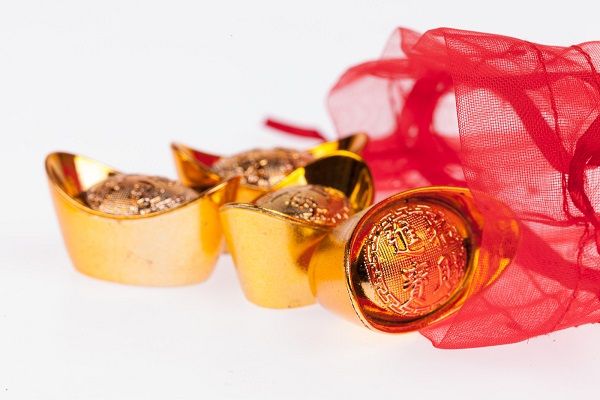
Wells Fargo Investment Institute analysts addressed that very question in an August 9 research note to clients. Here’s what they said: “We suspect gold will soon resume a leadership position.”
What could send gold prices higher again?
Chinese and Indian gold buying, Wells Fargo said. “The two largest country buyers, China and India, have been picking up purchases.”
In fact, gold imports moving from Hong Kong to the Chinese mainland surged from 38 metric tons a month to 154 metric tons a month, over the past three months, according to their report.
“Chinese gold purchases appear to be picking up. In the end, we think gold has much going for it, from negative real interest rates to quantitative easing to a new commodity bull super-cycle. All gold prices need, it seems, is a spark of interest, and we may be seeing it out of China,” Wells Fargo head of real asset strategy John LaForge wrote.
Another factor that could support long-term Chinese gold buying is the nation’s new “three-child policy,” according to World Gold Council Goldhub research.
In case you missed the news, recently China eased its decade’s long restriction on how many children Chinese couples can have. On May 31, China announced that married couples could now give birth to up to three children.
China’s current population of 1.41 billion – the largest in the world, could begin to rise even faster with the new policy.
What does this have to do with gold, you may ask?
While many Americans buy gold for investment purposes: portfolio diversification, a safe-haven, and a hedge against the devaluation in the dollar – the Chinese population buys gold for very different reasons.
In the East, buying gold is cultural tradition honed over time. Gold has a long-standing cultural importance in Asia that may be difficult for some Americans to even comprehend. For example, Chinese citizens commonly buy gold for the Chinese New Year. It is considered a sign of good fortune for what the New Year will bring. Also during China’s Spring Festival, the Chinese people also buy gold to bring themselves and other’s good luck. Many Chinese families also hold their wealth in physical gold as well – a longstanding tradition for hundreds of years.
Looking ahead, there is also a link between birth rates in China and long-term gold consumption – which brings us back to the new 3-child policy.
“The tradition of gifting gold – in various forms – to newborns, supports gold demand in China with the birth rates rising,” Goldhub research said on Aug. 3.
“We believe that the country’s efforts to boost the birth rate should be good news for Chinese gold retailers. First, it is tradition to gift gold to new-born babies in the form of locks, bracelets, anklets or zodiac-themed pendants for good luck. And sales of these gold products fluctuate with the number of new births each year in China. Second, as previously stated, a higher birth rate has the potential to lead to stronger economic growth in the long run, supporting retailers’ gold product sales,” Goldhub wrote.
What this means for you
If you’ve been considering increasing your allocation to gold, the recent price retreat gives you an excellent opportunity to buy even more gold with your dollars than just a month ago. The markets are moving every day and prices this low won’t last for long. Call Blanchard today at 1-800-880-4653 to ask about current pricing and availability.
Read the Goldhub research and see a photo of traditional baby gifting gold products here.
Want to read more? Subscribe to the Blanchard Newsletter and get our tales from the vault, our favorite stories from around the world and the latest tangible assets news delivered to your inbox weekly.
How Investors Are Handling Covid’s Third Act Twist
Posted on — Leave a commentThe biggest surprises always come in the third act. Covid is no exception.
The Delta variant continues to cause a surge of infections and deaths as 30% of those in the US still remain unvaccinated. As Dr. Anthony Fauci put it, “things are going to get worse.”
As the seven-day average of new daily cases rises businesses and investors are tempering their outlook. Previously the U.S. was experiencing approximately 10,000 cases a day. By early August that figure grew to about 84,000 and continue to increase. Recent estimates suggests that the number could get as high as 200,000 cases a day.
Investors and businesses are already taking action.
How do we know? Money-markets funds and banks are seeking ways to earn a safe and predictable return on their excess cash. They are doing so with a transaction called a reverse repurchase agreements, or “repos.”
In this kind of transaction, the lender purchases an asset like equipment or shares from the seller with an agreement to sell those same assets back to the seller at a set future date for a higher price. Today, money-market funds and banks are engaging in repos to the tune of $1 trillion in cash. This amount is the highest on record since the Federal Reserve allowed these kinds of transactions in 2013. The main reason for the influx of cash is likely the central bank’s decision to inch up their interest rate from 0% to 0.05%.
What is more concerning is the fact that this increase in repos might suggest that more institutions are in need of cash to fund short-term operations.
Meanwhile Moody’s Analytics has designed a “Back-to-Normal Index” intended to track the latest economic data. These metrics include things like the number of people flying, restaurant bookings and initial claims for unemployment benefits. This figure is beginning to look troubling for certain areas of the US, especially the south. Today, the index has fallen from it’s high reached in late June of this year.
Additional nation-wide lockdowns remain unlikely, and many experts believe the increase of hospitalizations will encourage at least some vaccine skeptics to get the shot. Despite this, the expectation for a booming summer and phenomenal second half to 2021 for investors is beginning to dim.
Proactive investors are taking this opportunity to read the road and make their smart moves before it is too late. For many this means keeping a significant amount of dry powder so that they can act when opportunities, like dropping asset prices, are presented. For others it means exploring the possibility of “safe haven” assets like gold that tend to benefit in climates of uncertainty and falling economic and business confidence.
It is too soon to know the extent of Delta’s economic impact. What we do know is that the situation is escalating and creating a picture much different than what most forecasted even one or two months ago. Medical professionals have also warned of the possibility that further variants can develop as we move into the winter months. The covid pandemic will end, but investors need to be prepared for a longer third act.
Want to read more? Subscribe to the Blanchard Newsletter and get our tales from the vault, our favorite stories from around the world and the latest tangible assets news delivered to your inbox weekly.
The Intriguing Numismatic Theory Behind This Coin
Posted on — 1 CommentAmericans had mixed feelings about the $3 gold piece. In the late 1880’s the $3 Indian Princess Head was worth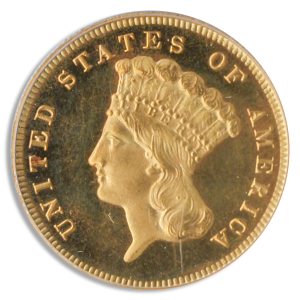 well over a day’s pay.
well over a day’s pay.
What’s more – it carried an odd number.
It turns out that very few people wanted to use coin which did not fit into the already accepted decimal calculations. Even though it was not heavily used in circulation – the $3 gold piece instantly captured the attention of coin collectors.
Numismatists began avidly seeking out and saving the intriguing $3 Indian Princess gold coin as early as 1879.
So why did the U.S. Mint decide to produce a $3 gold coin – especially since they already had a gold quarter eagle worth $2.50?
The surprising theory behind the origin of this coin is an unlikely culprit: a U.S. postage stamp. When this coin was minted a U.S. postage stamp cost 3 cents.
Numismatists believed that the sole purpose for creating the $3 coin was to create a convenient way for businesses to purchase 100 stamps in a single transaction.
Every U.S. coin denomination has a number of rarities. Yet, the $3 Indian Princess Head, minted from 1854-1889, is packed with so many low-mintage dates that the entire series is considered rare.
In 1880, for example, only 1,000 were minted. In 1881 only 500 were minted. And in 1882, only 1,500 were minted. Plus, many were lost to the melting pot in the 1930’s, reducing the number of survivors available today.
Many consider the $3 Indian Princess the most beautiful gold coin struck in the 19th century. See the rich and warm patina that comes with a 141 year old masterpiece here.
Designed by the U.S. Mint’s chief engraver, James B. Longacre, the $3 gold coin was the first time he had been given the freedom to create a design of his own. Longacre wrote that, previous to the $3 gold coin, he had been directed to adapt Roman or Greek features into U.S. coins. For the $3 gold coin, Longacre was determined to create something uniquely American.
“From the copper shores of Lake Superior to the silver mountains of Potosi, from the Ojibwa to the Araucanian, the feathered tiara is a characteristic of the primitiveness of our hemisphere as the turban is of the Asiatic,” Longacre wrote.
He was inspired to feature an “Indian Princess” on the obverse of this stunning coin. A lustrous orange-gold color, the coin shows a gorgeous Indian Princess adorned with a feathered headdress, with the words UNITED STATES OF AMERICA encircling her. On the reverse, the date and denomination is surrounded by an agricultural wreath celebrating corn, tobacco, cotton, and wheat.
Rare Coin Market Update
This summer we are seeing huge numismatic demand and extremely low inventory levels, which is contributing to rising prices.
In June 2021, the Rare Coin Values Index hit a new all-time record high of 434.28. (The Rare Coin Value Index is based on the combined percent change in retail prices for 87 rare United States coins and is updated monthly.)
Numismatic rarities that come onto the market can sell in a matter of days due to the limited supply and strong investor interest. Long-time numismatic investors are holding and expanding their collections when they can.
Investors are seeking opportunities to diversify their portfolios and protect and grow their wealth through tangible assets like rare coins – that are a non-correlated asset to the stock market. If there is a coin that you seek, call us today. We are often able to source even hard-to-find coins due to our deep connections inside the numismatic community.
Want to read more? Subscribe to the Blanchard Newsletter and get our tales from the vault, our favorite stories from around the world and the latest tangible assets news delivered to your inbox weekly.








